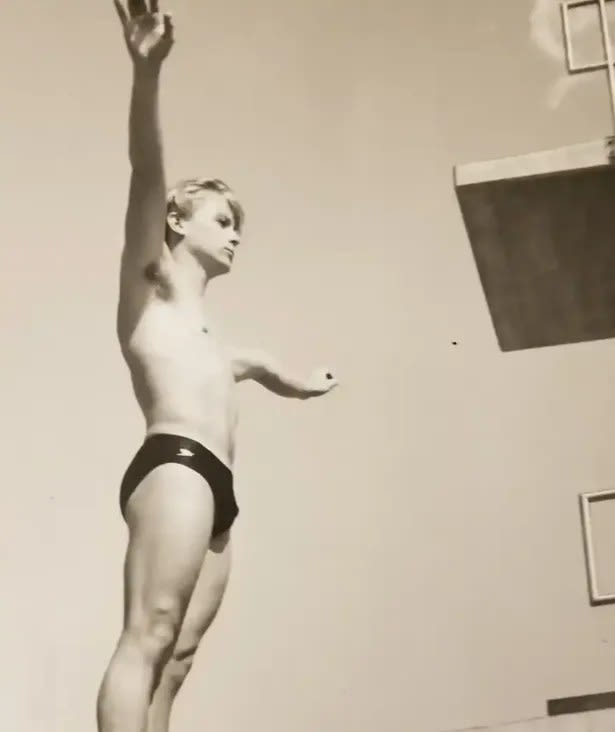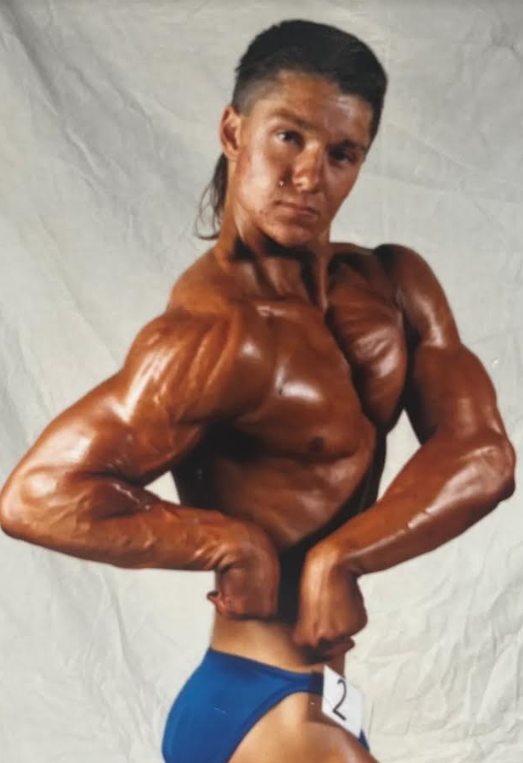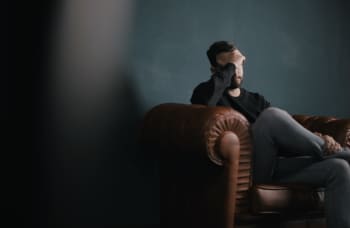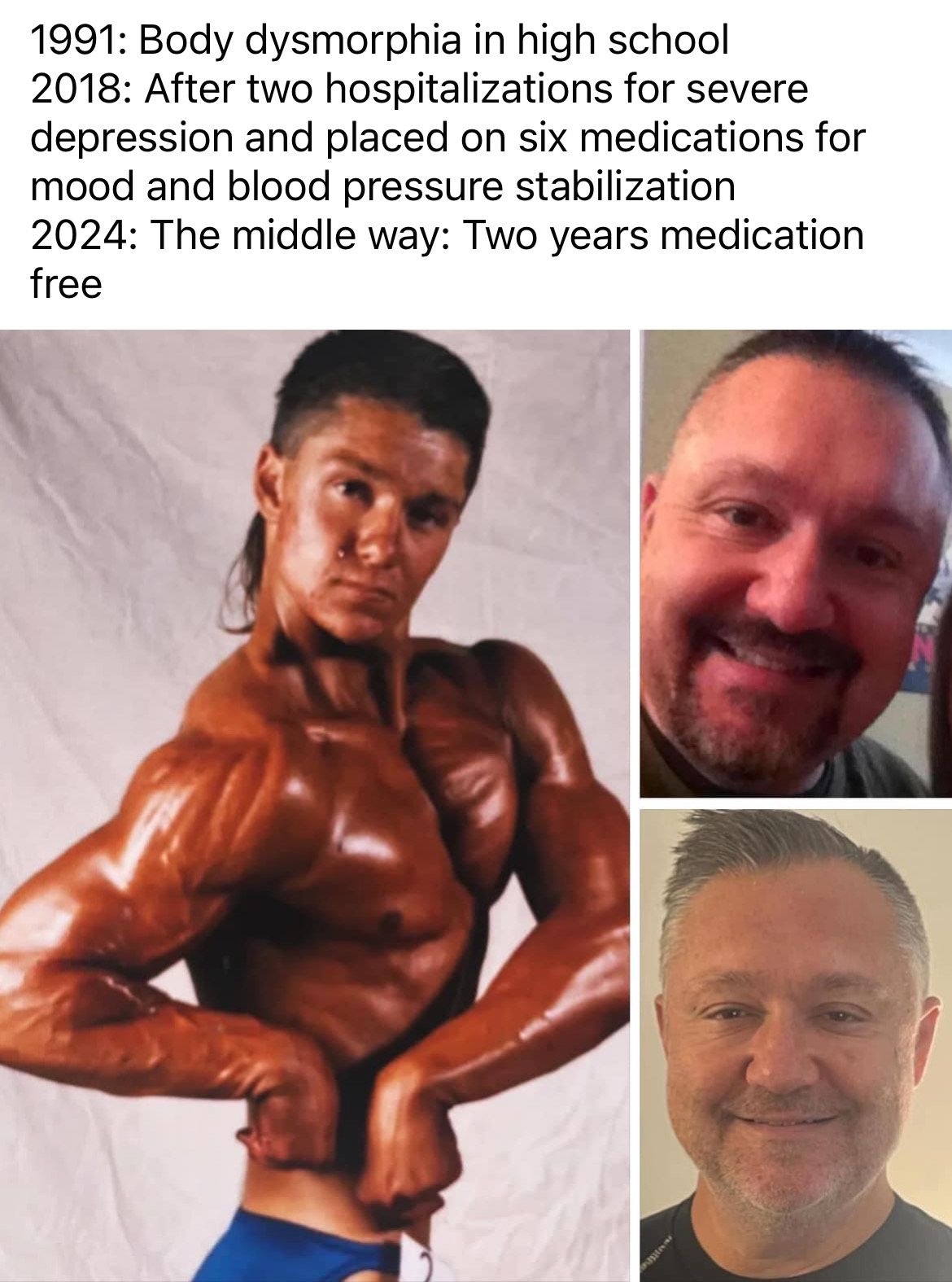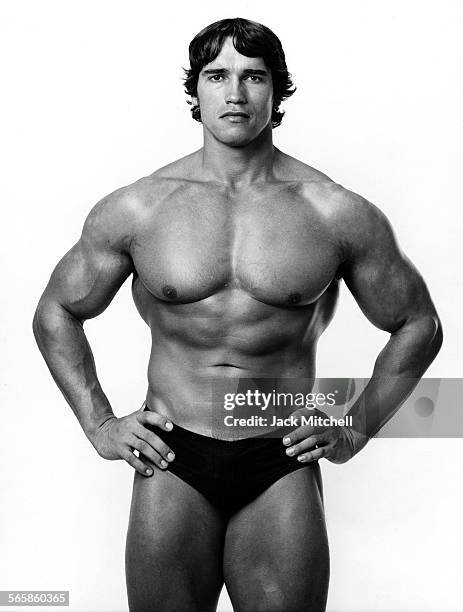Breaking the Mirror
Understanding and Overcoming Male Body Dysmorphic Disorder (MBDD)

As an Olympic Bound athlete, I found myself focused on body image and proportions. We had strict weigh-ins every week and were not allowed to gain weight. If we gained weight we were belittled and teased by the coaching staff and faced the possibility of not remaining on the team. We were expected to count and chart our calory intake every day and present them at the weigh in. Yet, we would binge the night before and vomit what we ate, joking that we got to taste it twice, and then we would make weight. What we were not aware of was the long-term effects it had on our mindset and health, like Male Body Dysmorphic Disorder (MBDD), Anxiety Disorder, Obsessive Compulsive Disorder (OCD), and eating disorders such as Bulimia and Anorexia. –John-Michael Lander
In a world where the ideal male physique is often glorified, many men find themselves trapped in an endless pursuit of physical perfection. For some, this quest becomes more than just a desire for a better body—it degenerates into a relentless obsession that takes over their thoughts, behaviors, and lives. This condition, known as Male Body Dysmorphic Disorder (MBDD), is a silent struggle faced by countless men, often hidden beneath layers of shame, insecurity, and societal expectations.
Unlike the more widely recognized forms of body dissatisfaction in women, MBDD remains largely misunderstood, driven by specific pressures like muscle dysmorphia and fueled by the pervasive influence of media and cultural norms. For male survivors of abuse and trauma, this disorder can be even more insidious, intertwining with their past experiences to create a unique and devastating set of challenges.
The misconception that Body Dysmorphia Disorder (BDD) primarily affects girls and women is debunked by recent studies. Editor for the Recovery Village, Rob Alston, sheds light on this disparity, revealing that nearly as many men as women grapple with dissatisfaction regarding their physical appearance. This revelation underscores the universality of body image struggles, regardless of sex.
Dr. Katharine Phillips, a professor of psychiatry at Weill Cornell Medical College and an attending psychiatrist at New York-Presbyterian/Weill Cornell Medical Center in New York City, is a renowned expert on body dysmorphic disorder. She notes that about 40% of those with BDD are men, and body issues in boys and young men in athletics are prevalent. Additionally, about two-thirds of those diagnosed with BDD also have a substance use disorder, usually caused in part by body image concerns. Many with BDD have experienced trauma or abuse, further complicating their mental health landscape.
The added complexities faced by survivors, athletes, and everyday males shed light on the barriers that prevent them from seeking the effective treatments and support systems that can pave the way to recovery. Through understanding and awareness, we can begin to break the silence surrounding MBDD and offer a path to healing for those who suffer in the shadows.
Known for his ultra lean physique, Andreas Munzer’s extreme use of steroids and diuretics led to fatal organ failure at age 31.
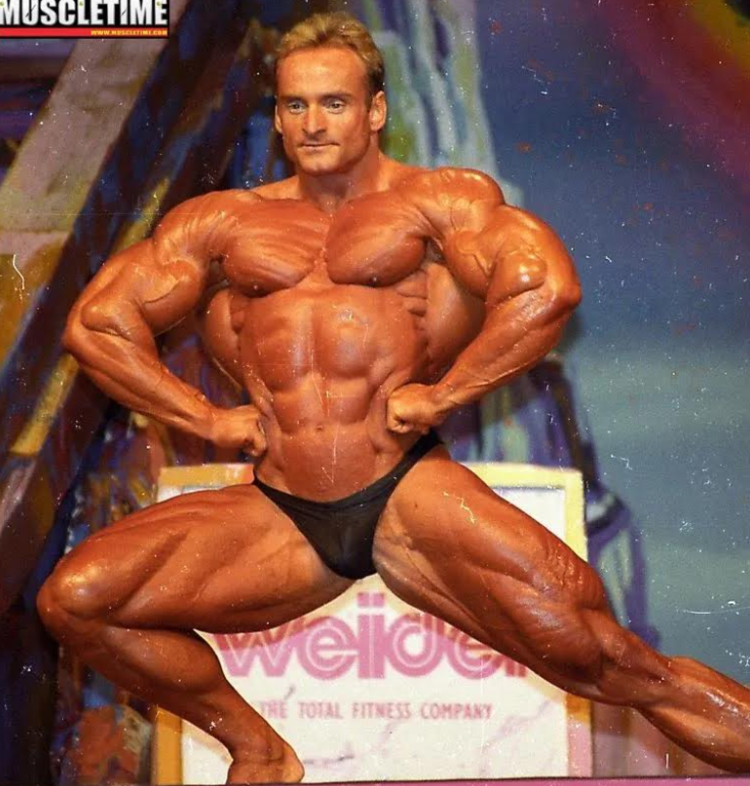
Understanding Male Body Dysmorphic Disorder
MBDD is more than just a fleeting concern about appearance—it's a severe mental health condition that warps an individual's perception of their own body. MBDD often fixates on specific physical traits, leading to an obsessive preoccupation with perceived flaws that others might barely notice, or not at all. This disorder can manifest in various ways, including intense anxiety over muscle size, skin imperfections, hair loss, the symmetry of facial features, or even genital preoccupation.
Unlike the normal self-consciousness that many experience, MBDD drives men to engage in repetitive and often harmful behaviors. They may spend hours scrutinizing themselves in mirrors, excessively grooming, or seeking reassurance from others, all in a desperate attempt to feel 'normal.' Some go to extreme lengths, resorting to cosmetic procedures or punishing exercise regimens to correct these perceived defects. But no matter how much they try to change their appearance, satisfaction remains out of reach, replaced instead by an overwhelming sense of inadequacy and self-loathing.
The roots of MBDD are complex, involving a combination of genetic, psychological, and environmental factors. Social and cultural influences play a significant role, with the media bombarding men with images of the 'perfect' male body—muscular, lean, and flawless. These unrealistic standards can plant the seeds of body dissatisfaction, which, when combined with personal vulnerabilities, may grow into the full-blown disorder that is MBDD.
But MBDD isn't just about vanity or low self-esteem. It is a serious mental health condition that can severely disrupt a man's life, affecting his relationships, work, and overall well-being. The constant preoccupation with appearance often leads to social withdrawal, depression, and even suicidal thoughts. Yet, despite its profound impact, MBDD remains underrecognized and underdiagnosed, with many men suffering in silence, unaware that their struggles have a name—and that help is available.
Understanding MBDD is the first step toward addressing it. By shedding light on what this disorder truly entails, we can begin to challenge the stereotypes, break down the barriers to treatment, and offer support to those who need it most.
A former natural teenage bodybuilder and current child wellness advocate, Dr. Viktor Paul Giangrasso is very outspoken about Muscle Dysmorphia (MD) and the misperception many people, even in academia, carry. “When I was receiving my doctorate degree in Physical Therapy around 2005, I approached a guest lecturer speaking about the 'female athlete triad'. When I attempted to address that the 'disordered eating' component also impacts males, she expressed that this was a predominantly female issue, and the conversation ended rather abruptly. This lecturer did not begin to gain any understanding of my struggles as a male with MD, the extreme dieting, exercise obsession, and crippling body image preoccupation I was going through. Four years later I was hospitalized for the first of two times for severe depression and suicidal ideation.”
The Impact of Media and Cultural Expectations on Men's Body Image
In today’s hyperconnected world, the influence of media and cultural expectations on men’s body image is more pervasive than ever. From billboards to social media feeds, the idealized male physique is constantly on display—muscular, chiseled, and seemingly effortless. These images set an unrealistic standard that can be nearly impossible to attain, yet they are relentlessly promoted as the epitome of masculinity and success.
For many men, this relentless barrage of “the perfect body” creates a deep sense of inadequacy and fuels an obsession with physical appearance. The pressure to conform to these ideals can lead to an unhealthy fixation on body image, where self-worth becomes tied to the number on a scale, the definition of muscles, or the appearance of skin. Social media platforms exacerbate this issue by creating a distorted mirror of reality. With filters, editing tools, and carefully curated content, the images that men see online are often far removed from the truth, yet they become the benchmarks against which they silently measure themselves.
This culture of comparison is especially damaging for those already vulnerable to body dissatisfaction. The constant exposure to unattainable body ideals can ignite or worsen MBDD. For these individuals, the media's portrayal of “the perfect body” doesn't just set a high bar—it creates a never-ending spiral of self-criticism and despair.
But the media isn’t the only culprit. Cultural expectations also play a significant role in shaping men’s perceptions of their bodies. In many societies, traditional notions of masculinity emphasize strength, control, and dominance. These traits are often symbolized by a muscular physique, leading men to equate their physical appearance with their value as individuals. The fear of not measuring up to these standards can drive men to extreme lengths, from excessive dieting and exercise to the use of steroids and other dangerous substances.
This toxic combination of media influence and cultural pressure doesn't just impact men’s self-esteem—it can have far-reaching consequences on their mental health. Anxiety, depression, and social isolation are common among those who feel trapped in the pursuit of the “ideal” body. And for some, the need to attain this ideal becomes an all-consuming obsession, leading to the development or exacerbation of MBDD.
Breaking free from these harmful influences requires a shift in how we perceive and portray the male body. By challenging the unrealistic standards set by the media and redefining what it means to be masculine, we can help men build a healthier, more positive relationship with their bodies. It’s time to create a culture that values long-term wellness, diversity, self-acceptance, and mental well-being over impossible ideals.
One of the largest bodybuilders, Greg Kovacs’ size led to an early death due to heart failure.

Recognizing the Signs and Symptoms of Male Body Dysmorphic Disorder
MBDD is often a hidden struggle, masked by societal norms that discourage men from expressing vulnerability about their appearance. Yet, beneath the surface, those suffering from MBDD endure a relentless battle with their own reflection, fixating on perceived flaws that others might barely notice, or not notice at all. Recognizing the signs and symptoms of MBDD is crucial for early intervention and support, as this disorder can deeply affect a man’s mental health and quality of life.
At the core of MBDD is an obsessive preoccupation with a specific aspect of one’s bodily appearance. This preoccupation isn’t just a mild concern; it becomes an all-consuming focus that dominates a man’s thoughts, behaviors, and emotions. Men with MBDD may spend hours scrutinizing themselves in mirrors, repeatedly checking or “correcting” the area of concern, or avoiding mirrors altogether to escape the distressing sight.
These behaviors are often accompanied by a deep sense of shame and embarrassment, leading men to go to great lengths to hide their perceived imperfections. They might layer their clothing, avoid certain angles in photographs, or even withdraw from social activities to prevent others from seeing what they believe to be glaring flaws. In some cases, this anxiety can escalate to the point of social isolation, as the fear of being judged or ridiculed becomes too overwhelming to bear.
The compulsive behaviors associated with MBDD are not limited to mirror checking. Many men engage in excessive grooming, such as constant hair styling, shaving, or skin care routines, to “fix” the issue(s). Others might seek reassurance from friends, family, or even strangers, only to find that no amount of validation can quiet the internal voice that insists something is wrong.
Physical symptoms can also accompany mental and emotional distress. Some men may turn to extreme exercise regimens, dangerous dieting, or the use of steroids to achieve the “perfect” body. The constant focus on appearance can lead to severe anxiety, depression, and in some cases, suicidal thoughts. Despite these significant impacts, many men with MBDD do not seek help, often due to a lack of awareness about the disorder or the stigma surrounding mental health issues.
Recognizing these signs and symptoms is the first step in addressing MBDD. If you or someone you know is obsessively focused on a particular aspect of appearance, experiences significant distress related to body image, or engages in compulsive behaviors to “correct” perceived flaws, it may be time to seek professional help. Early intervention can make a significant difference, helping men to break free from the cycle of obsession and self-criticism and move towards a healthier, more balanced perspective on their bodies.
By increasing awareness and understanding of MBDD, we can help those who suffer in silence to find their voice and reclaim their lives from the grip of this debilitating disorder.
The mental strain of having to have the perfect body caused Bertil Fox’s illustrious career to be derailed by murdering his fiancée and her mother.
Male Body Dysmorphic Disorder in Survivors of Abuse with Ena Lucia Mariaca Pacheco
Ena Lucia Mariaca Pacheco, Human Security Expert, shares her research on male survivors and MBDD.
Survivors of trauma, particularly those who have experienced childhood sexual abuse, exploitation, and trafficking, often struggle with profound psychological challenges, one being body dysmorphia. For many male survivors, their trauma manifests in eating disorders and intense self-hatred, a reflection of their internalized belief of not being "good enough," brought on by years of trauma-bonding and grooming, which can lead to long-lasting confusion and a fractured sense of self. During sexual abuse and exploitation, body dysmorphia is emphasized by abusers and traffickers to control their victims, by causing self-doubt, self-hatred, and to ensure that "clients" get what they paid for - this is a manipulative control tactic. Perpetrators can make boys look like girls, leading them to feel confused about who they area. As these boys grow into adulthood, they may adopt hyper-masculine personas or stoic behaviors as defense mechanisms to distance themselves from their traumatic past and avoid confronting their abuse.
The impact of such experiences is not limited to their self-perception but also extends to how they relate to others and navigate society. The intense confusion and internalized negative beliefs forced upon these boys can severely disrupt their mental state. Survivors often report difficulties with physical intimacy, emotionally avoidant behaviors, and dissociative disorders. "My abuse began as an infant and forms a mosaic of cracks in my ego that have taken a lifetime to repair," as one survivor described, illustrates the long-term and deeply ingrained damage that such abuse can cause, leading to complex-PTSD and a lifetime of effort to repair their fractured sense of self. This struggle with body image and personal image is further complicated by societal expectations, which can inhibit disclosure and perpetuate feelings of shame and inadequacy.
Body dysmorphia, eating disorders, and profound body hatred are significant and often interrelated challenges faced by female and male survivors of childhood sexual abuse and exploitation. The deep-seated trauma from such experiences can warp a survivor's perception of their body, leading to an obsession with perceived flaws that are either minor or entirely imagined. This distorted self-image can manifest as body dysmorphic disorder, where survivors may fixate on their appearance, constantly comparing themselves to others, and engaging in behaviors to conceal or "correct" these perceived imperfections. For male survivors, these struggles are frequently compounded by being forced to look or act like a girl during abuse, leaving them with a conflicted and confused sense of self that exacerbates their body image issues.
Eating disorders often emerge as a coping mechanism in response to this body dysmorphia and the accompanying self-hatred. Many survivors in the research project stated that they develop a toxic relationship with food and their bodies, using restrictive eating, bingeing, purging, or excessive exercise as a means of exerting control over an aspect of their lives when so much has felt beyond their control. This destructive cycle can be fueled by the internalized belief that they are not "good enough," leading to self-punishment through disordered eating and a relentless pursuit of an unattainable body ideal. The combination of body dysmorphia, eating disorders, and deep-seated body hatred forms a vicious cycle that further entrenches the survivor in feelings of shame, inadequacy, and isolation, making it incredibly challenging to heal and rebuild a positive sense of self.
For sports athletes, overcoming these challenges can be even more difficult, especially when there is an intense focus on physical appearance and performance in their field. The pressure to maintain a certain physique, combined with constant scrutiny from coaches, teammates, and fans, can exacerbate existing insecurities, especially if their abusers or traffickers were their coach, trainer, or part of their sporting community.
Despite the profound challenges that survivors face, hope and healing are possible. Recovery often begins with acknowledging the trauma and its impact, followed by seeking support through therapy, support groups, or trusted relationships. Healing is a gradual process that involves rebuilding a fractured sense of self, learning to challenge and reframe negative beliefs, and fostering self-compassion. Many survivors find strength in reconnecting with their bodies through practices like mindfulness, yoga, or art therapy, which can help them regain a sense of control and appreciation for their physical selves. Over time, with patience and persistence, survivors can cultivate a renewed sense of identity, moving from a place of self-hatred to one of self-acceptance and, eventually, self-love. The journey is difficult, but with the right support and resources, survivors can reclaim their lives and find peace and empowerment in their healing process.
Ultimately, my hope for those who are struggling with body dysmorphia and eating disorders, is that they can one day look in the mirror, see their body, and say, "I love you, I am proud of you, you are important, and I appreciate how you've carried me through everything up to this point, we have survived together."
For more information, please reference pages 130-133 on Ena Lucia's Thesis: https://www.viurrspace.ca/handle/10613/26077

Olympic silver medalist, Gus Kenworthy, shared that he doesn’t think he has the perfect body and has experienced body dysmorphia, the same way that many gay people do.
The Psychological and Social Consequences of Male Body Dysmorphic Disorder (MBDD)
The effects of MBDD extend far beyond the mirror. This debilitating condition doesn't just distort how men see themselves; it warps their entire experience of the world. The psychological and social consequences of MBDD are profound, often leading to a life marked by anxiety, depression, and isolation. As the disorder tightens its grip, it can erode a man’s confidence, strain relationships, and hinder his ability to function in everyday life.
At the psychological level, MBDD is a relentless mental battle. Men with the disorder are trapped in a cycle of obsessive thoughts and compulsive behaviors, constantly preoccupied with their perceived flaws. These thoughts aren't just fleeting insecurities—they are all-consuming, dominating a man’s mind and leaving little room for anything else. The constant focus on appearance can lead to severe anxiety, as every social interaction becomes a minefield of potential judgment. Even routine activities, like going to the gym or attending a work meeting, can trigger intense distress, driven by the fear that others will notice their 'defects.'
Relationships, both personal and professional, often suffer as a result. In romantic partnerships, MBDD can create tension and distance, as men struggle with intimacy and vulnerability. The constant need for reassurance can be exhausting for both partners, leading to misunderstandings and conflicts. At work, the impact of MBDD can be just as severe. The disorder can affect concentration, productivity, and confidence, making it difficult for men to perform at their best. In some cases, men may even avoid pursuing career opportunities or promotions out of fear that they won't be able to meet the expectations placed on them.
The shame and embarrassment that often accompany MBDD can make it difficult for men to seek help. Many feel that their concerns will be dismissed as vanity or that they should be able to 'get over it' on their own. This reluctance to reach out for support only deepens the isolation and prolongs the suffering, as MBDD continues to take a toll on every aspect of their lives.
Getty Images
Getty Images
Jeremy Abbott, a two-time Olympian shared that in all honesty, his body image is probably very low, and still looks in the mirror and nitpicks everything.
Barriers to Seeking Help for Male Body Dysmorphic Disorder
For many men suffering from MBDD, the path to recovery is obstructed by numerous barriers, both internal and external. One of the most significant barriers is the pervasive stigma surrounding mental health, particularly for men. From a young age, many men are taught to suppress their emotions, to be tough and self-reliant, and to avoid showing any signs of vulnerability. Admitting to a mental health issue, especially one related to body image, can feel like a betrayal of these deeply ingrained ideals of masculinity. The fear of being perceived as weak or 'unmanly' often prevents men from acknowledging their struggles, let alone reaching out for help.
Compounding this issue is the lack of awareness and understanding of MBDD itself. While many people are familiar with the concept of body dissatisfaction, the specific nature of MBDD—its obsessive focus on perceived flaws and the compulsive behaviors that accompany it—remains largely misunderstood. This lack of knowledge can make it difficult for men to recognize that what they are experiencing is a serious mental health condition, rather than just a case of low self-esteem. Without this understanding, men may not realize that effective treatment options are available, and instead, they continue to suffer in isolation.
Stereotypes about men and women play a significant role in creating these barriers. Society often views concerns about appearance as 'women's issues,' leaving men who struggle with body image to feel marginalized or dismissed. This cultural bias can make it difficult for men to find spaces where their experiences are validated and taken seriously. Even within the medical community, MBDD in men may be overlooked or misdiagnosed, with healthcare providers focusing on more commonly recognized male issues, such as substance abuse or depression, without addressing the underlying body image disorder.
The fear of judgment and ridicule also looms large. Men with MBDD often worry that others will see them as vain or superficial if they reveal the extent of their preoccupation with appearance. This fear is particularly strong in social or professional contexts, where men may feel that admitting to MBDD could damage their reputation or relationships. As a result, they may go to great lengths to hide their symptoms, further entrenching the disorder and delaying the possibility of recovery.
Financial and logistical barriers can also stand in the way of seeking help. Access to mental health care, including specialized treatment for MBDD, can be limited by cost, availability of services, and geographic location. Men who are already struggling with the psychological and social burdens of MBDD may find it overwhelming to navigate these practical challenges, especially if they are unsure of where to turn or how to start the process of getting help.
Breaking down these barriers requires a concerted effort to change the narrative around mental health and masculinity. Education and awareness campaigns are essential to destigmatizing MBDD and encouraging men to view seeking help as a sign of strength, not weakness. Healthcare providers must also be equipped with the knowledge and sensitivity to recognize and treat MBDD in men, offering them the validation and support they need.
Support networks, both formal and informal, play a critical role in this process. Friends, family, and colleagues can make a difference by offering a nonjudgmental space where men feel safe to express their concerns and seek guidance. Online communities and support groups specifically tailored to men with MBDD can also provide a sense of connection and understanding, helping to break the isolation that so often accompanies the disorder.
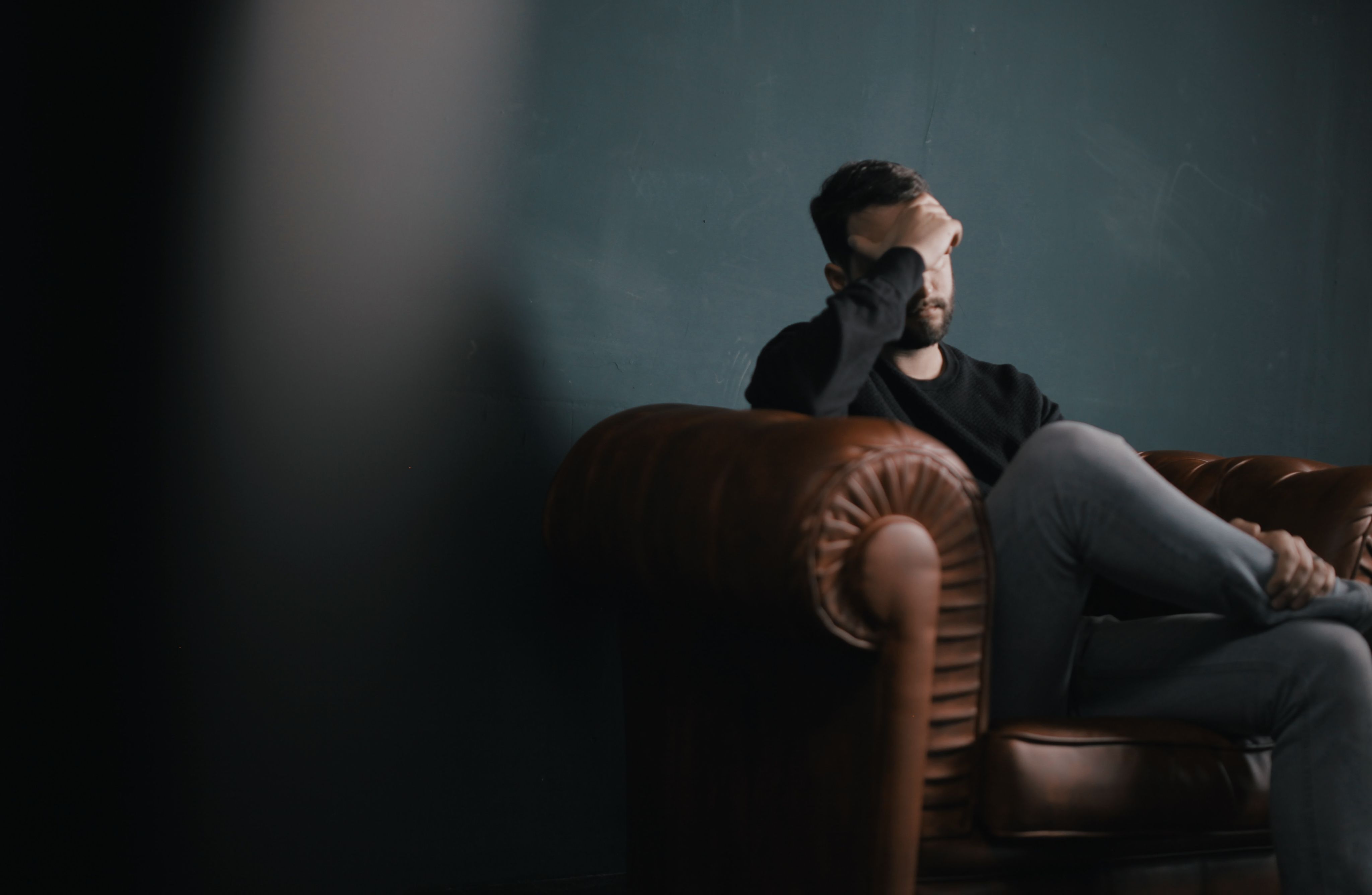
Adam Rippon, Olympic figure skater, said that for him it was a body function, because his competitors did not look like him…they are very thin…and he was trying hard to fight that causing mental strain and eating disorders.
Dr. Viktor Paul Giangrasso outlines three empowering hope strategies for fostering long-term mental, physical, and relational wellbeing in men.
Firstly, reflection via honest introspection is key. By delving deep into personal trauma and simply being with it, including harmful sexual experiences, men can address their blind spots and navigate life's challenges with greater resilience and self-awareness.
Secondly, transparent and compassionate communication with trusted others regarding uncomfortable boyhood or adolescent experiences is essential. By creating safe spaces for dialogue, individuals can acknowledge and relationally process underlying traumas, paving the way for healing, growth and connection.
Finally, a shift in mindset is imperative. Rather than adhering to shortsighted ideals of size and performance, men must prioritize long-term holistic body-mind wellness. Embracing vulnerability and authenticity, they can redefine what it means to "be a man" in today's society.
While healing is relational, thus the important need for support from others, Dr. Viktor elaborates on the first and the third of these three strategies:
I was on six different medications for emotional issues and hypertension. I was in therapy, and involved in support groups, but I knew I needed more to help overcome my trauma. My MBDD, manifesting most notably as genital preoccupation and muscle dysmorphia, became unmanageable and landed me in the hospital twice for suicidal ideation. Thankfully, I was stabilized with meds and regular therapy/support groups, however, over time I realized medication was no longer serving my deeper need to heal. I researched different mind/body modalities and came upon Sensory deprivation floating and Neuro feedback.
I floated for a five-year period and participated in neurofeedback treatments for a year and a half. Simultaneously, I cultivated a consistent meditation practice and got regular physical exercise. Over about a two-year period, I was able to safely come off the sixth medication. I attribute this to consistent usage of these two mind/body modalities.
While floating, I was making a personal choice to simply be with rather than run from myself and my debilitating trauma. In the float tank, I was able to face all of me. While in neurofeedback, I made the choice to regulate the dysregulated electrical waves in my brain. Through these modalities I learned that I don't need the perfect body which I thought I needed to find peace. That was a belief grounded in trauma compensation and avoidance of my issues. While my early traumatic sexual experiences disconnected me from my body, hence the need to obsess over my body, these two modalities reconnected me. I am now over two years medication free and continue to meditate and exercise. However, I don’t sit with myself quietly or workout because I need the perfect body or perfect mind. Now I accept and appreciate my body as it is, the beautiful mechanism I use to be in the world to experience both the beauty and suffering of life. I enjoy the process of taking care of myself.
Romario Dos Santos Alves’ aspiring desire to resemble the Incredible Hulk was enhanced by excessive use of synthol. His dream became a nightmare with severe mental and physical health problems.
Effective Treatments and Support for Male Body Dysmorphic Disorder
The journey to recover from MBDD is challenging, but it is also possible, with the right treatment and support. For men struggling with this debilitating condition, understanding that they are not alone—and that effective help is available—can be the first crucial step towards healing. While MBDD can feel overwhelming, it is important to know that there are proven strategies and therapies that can make a real difference in managing the disorder and improving quality of life.
One of the most effective treatments for MBDD is Cognitive-Behavioral Therapy (CBT), particularly a specialized form known as Exposure and Response Prevention (ERP). CBT helps individuals recognize and challenge the distorted thoughts and beliefs that drive their obsession with perceived flaws. By gradually exposing themselves to feared situations—such as looking in the mirror without engaging in compulsive behaviors—men with MBDD can learn to reduce their anxiety and break the cycle of negative thoughts and rituals. This process is not easy, but with the guidance of a skilled therapist, it can lead to significant improvements in how men perceive themselves and their bodies.
In some cases, medication may also be a useful tool in treating MBDD. Selective Serotonin Reuptake Inhibitors (SSRIs), a type of antidepressant, have been shown to help reduce the obsessive thoughts and compulsive behaviors associated with the disorder. While medication is not a cure, it can be an important part of a comprehensive treatment plan, particularly for those who are experiencing severe symptoms or who have not responded to therapy alone.
Beyond individual therapy, group therapy and support groups can offer additional benefits. These settings provide men with the opportunity to connect with others who are facing similar challenges, fostering a sense of community and understanding that is often missing in their daily lives. Sharing experiences and coping strategies in a supportive environment can help to reduce the feelings of isolation and shame that so often accompany MBDD. Moreover, hearing others' stories of progress and recovery can be incredibly empowering, offering hope and motivation to continue the journey toward healing.
Family therapy can also play a crucial role in the recovery process. MBDD doesn’t just affect the individual; it impacts their relationships with loved ones as well. Family therapy can help to educate family members about the disorder, improving their understanding and equipping them with the tools to provide appropriate support. It can also address any interpersonal issues that may have arisen because of the disorder, helping to rebuild trust and communication within the family unit.
Another key component of effective treatment for MBDD is self-care. Developing healthy habits, such as regular exercise, balanced nutrition, and adequate sleep, can have a positive impact on mental health and overall well-being. Mindfulness practices, such as meditation or yoga, can also help men to stay grounded in the present moment, reducing the intensity of their obsessive thoughts and enhancing their ability to cope with stress.
While professional treatment is essential, it's also important to recognize the value of a strong support system. Friends, family, and partners can be invaluable allies in the recovery process, offering encouragement, understanding, and practical assistance. For men who may feel uncomfortable discussing their struggles with those close to them, online communities and forums can provide a safe space to share their experiences and seek advice from others who truly understand what they are going through.
Ultimately, the path to recovery from MBDD is a highly personal one, and what works for one person may not work for another. The key is to remain open to different approaches, and to be patient with oneself as progress is made, however slow it may seem. With the right combination of therapy, medication, self-care, and support, men can learn to manage their symptoms, regain control over their lives, and develop a healthier, more accepting relationship with their bodies.
Recovery is not about achieving perfection—it's about finding peace and contentment within oneself. By taking that first step towards seeking help, men with MBDD can begin to break free from the disorder’s grip, moving towards a future where they can appreciate themselves for who they truly are, not just how they appear.

Arnold Schwarzenegger, 7-time Mr. Olympia between 1970 and 1980, stated that when he looked in the mirror, he would say to himself that he did not know how this s**t body could ever win.
Conclusion
MBDD is a profound struggle that affects far more than just self-image. It infiltrates every aspect of life, from mental health to relationships, and can be especially challenging for survivors of trauma. Yet, by understanding the nature of MBDD, recognizing its signs, and addressing the barriers to seeking help, we can make significant strides towards healing.
Effective treatment, including practices that encourage looking inward, medication, and support from loved ones, offers hope and practical pathways to recovery. By fostering a culture of openness and acceptance, we can dismantle the stigma that keeps many men from seeking the help they need and create supportive environments that encourage healing.
Ultimately, the journey towards overcoming MBDD is about more than just changing how one looks—it's about reclaiming one's sense of self-worth, building meaningful connections, and finding peace within. With the right support and strategies, men can break free from the cycle of obsession and self-criticism, embracing a healthier and more fulfilling life.
Resources
Dr. Viktor Paul Giangrasso: https://viktorpaul.com/
Ena Lucia Mariaca Pacheco: Thesis: https://www.viurrspace.ca/handle/10613/26077 , enaluciamariacapacheco@gmail.com
Rob Alston: Body Dysmorphic Disorder in Men: Statistics, Impact, and More (therecoveryvillage.com)
Dr. Katharine Phillips: Eating Disorders and Body Image Issues in Boys and Men | U.S. News (usnews.com)
5 Bodybuilders Who Took It Too Far #shorts #fitness (youtube.com) Andreas Munzer, Greg Kovac, Bertil Fox, and Romario Dos Santos Alves
Athletes’ Quotes:
Jeremy Abbott: Adam Rippon on Quiet Starvation in Men’s Figure Skating - The New York Times (nytimes.com)
Gus Kenworthy: Gus Kenworthy Opens Up About 'Absolute Body Dysmorphia'
Adam Rippon: Adam Rippon opens up about eating disorders in figure skating (nbcnews.com)
Arnold Schwarzenegger: “I hated how my body looked” -Arnold Schwarzenegger
About the Author:
John-Michael Lander is a Survivor, Advocate, Author & Public Speaker
He is also the founder of An Athlete's Silence: www.anathletessilence.com
Published by SurvivorSpace, an initiative of Zero Abuse Project

